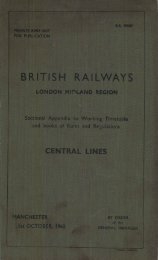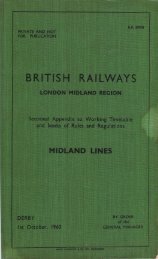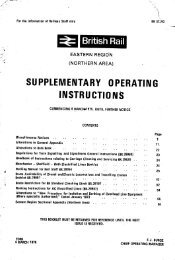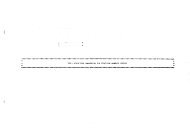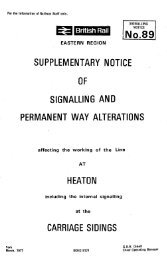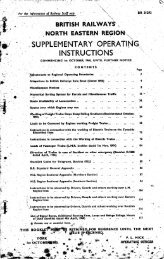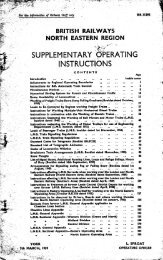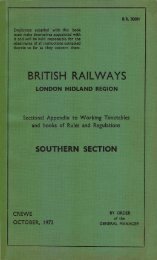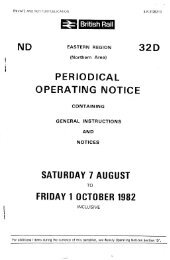general instructions. - Limit Of Shunt
general instructions. - Limit Of Shunt
general instructions. - Limit Of Shunt
Create successful ePaper yourself
Turn your PDF publications into a flip-book with our unique Google optimized e-Paper software.
132 G e n e r a l <strong>instructions</strong>.--Continued.<br />
Coaching Stock Vehicles in rear of Pas!anger Trains, etc.—Continued.<br />
5.—Catt1e wagons fully braked or piped when fitted with screw couplings,<br />
may be attached to passenger trains as shewn, provided the permission of<br />
the District Superintendent has been obtained.<br />
Fully braked cattle wagons when attached to passenger trains may be<br />
counted in the same way as horse boxes, fish trucks, or other four-wheeled<br />
fully braked vehicles for the purpose of carrying out the <strong>instructions</strong> in para. 1,<br />
page 127.<br />
Fully braked cattle wagons may also if necessary, be placed behind the<br />
rear van of a passenger train on sections of line where cattle wagons are<br />
authorised to run on passenger trains, to the extent shewn in the column<br />
headed "No. of braked coaching stock vehicles which may be conveyed<br />
behind rear van," provided this does not exceed the limit set out in the list<br />
referred to in clause 6.<br />
When piped cattle wagons are attached to passenger trains the proportions<br />
laid down in para. 1, page 127, must be - strictly observed.<br />
6.—The limit as to the number of cattle wagons on each train to be as<br />
shewn in the following list, and piped wagons must, as far as possible, be<br />
attached in the position indicated, but under no circumstances- must more<br />
than one piped wagon be attached behind the rear van and then only on<br />
sections where authority is given for a piped vehicle to be run behind the<br />
rear van.<br />
7.—Wagons with cast-iron wheels or dead buffers must not be attached<br />
to any train conveying passengers.<br />
The <strong>instructions</strong> only apply when the automatic brake in use on the train<br />
is in proper working order. ( O . 7102.)<br />
On the undermentioned parts of the line i10 VeiliCie of any kind<br />
must be attached behind the rear hr ke van<br />
From Hexham to Allendale. From Piercebridge to Kirkby Stephen..<br />
Allendale to Hexham.<br />
• )<br />
1<br />
, Haltwhistle to Alston.<br />
1<br />
Staintondale to Ra,venscar.<br />
Alnwick<br />
Coldstream<br />
to<br />
to<br />
Coldstream.<br />
Robin Hood's Bay to Hawsker.<br />
Alnwick.<br />
1Whitby<br />
Town to Loftus.<br />
\<br />
Ferryhill to Trip:don.<br />
. Loftus to West Cliff.<br />
Hart to Hesieden.<br />
,<br />
1West<br />
Cliff to Ravenscar.<br />
1 Wear Valley Junction to<br />
Grosmont to Summit Box.<br />
Tow Law. •<br />
( Levisham to Summit Box.<br />
Blackhill to Burnhill.<br />
i<br />
r<br />
Unless there is an assisting engine in the<br />
k<br />
rear from Kirkby Stephen.<br />
NOTE.- Where autocars are run over any of the b sections shewn above, one vehicle<br />
provided it is proper19 braked, may be attached y in the rear as a trailer.<br />
S<br />
t<br />
e<br />
p




